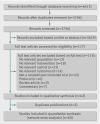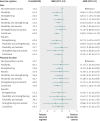Exercise for lower limb osteoarthritis: systematic review incorporating trial sequential analysis and network meta-analysis
- PMID: 24055922
- PMCID: PMC3779121
- DOI: 10.1136/bmj.f5555
Exercise for lower limb osteoarthritis: systematic review incorporating trial sequential analysis and network meta-analysis
Abstract
Objective: To determine whether there is sufficient evidence to conclude that exercise interventions are more effective than no exercise control and to compare the effectiveness of different exercise interventions in relieving pain and improving function in patients with lower limb osteoarthritis.
Data sources: Nine electronic databases searched from inception to March 2012.
Study selection: Randomised controlled trials comparing exercise interventions with each other or with no exercise control for adults with knee or hip osteoarthritis.
Data extraction: Two reviewers evaluated eligibility and methodological quality. Main outcomes extracted were pain intensity and limitation of function. Trial sequential analysis was used to investigate reliability and conclusiveness of available evidence for exercise interventions. Bayesian network meta-analysis was used to combine both direct (within trial) and indirect (between trial) evidence on treatment effectiveness.
Results: 60 trials (44 knee, two hip, 14 mixed) covering 12 exercise interventions and with 8218 patients met inclusion criteria. Sequential analysis showed that as of 2002 sufficient evidence had been accrued to show significant benefit of exercise interventions over no exercise control. For pain relief, strengthening, flexibility plus strengthening, flexibility plus strengthening plus aerobic, aquatic strengthening, and aquatic strengthening plus flexibility, exercises were significantly more effective than no exercise control. A combined intervention of strengthening, flexibility, and aerobic exercise was also significantly more effective than no exercise control for improving limitation in function (standardised mean difference -0.63, 95% credible interval -1.16 to -0.10).
Conclusions: As of 2002 sufficient evidence had accumulated to show significant benefit of exercise over no exercise in patients with osteoarthritis, and further trials are unlikely to overturn this result. An approach combining exercises to increase strength, flexibility, and aerobic capacity is likely to be most effective in the management of lower limb osteoarthritis. The evidence is largely from trials in patients with knee osteoarthritis.
Protocol registration: PROSPERO (www.crd.york.ac.uk/prospero/) No CRD42012002267.
Conflict of interest statement
Competing interests: All authors have completed the ICMJE uniform disclosure form at
Figures



Republished in
-
Exercise for lower limb osteoarthritis: systematic review incorporating trial sequential analysis and network meta-analysis.Br J Sports Med. 2014 Nov;48(21):1579. doi: 10.1136/bjsports-2014-5555rep. Br J Sports Med. 2014. PMID: 25313133
Comment in
-
ACP Journal Club. Review: Strength training, with or without flexibility and aerobic training, reduces pain in lower limb osteoarthritis.Ann Intern Med. 2013 Dec 17;159(12):JC7. doi: 10.7326/0003-4819-159-12-201312170-02007. Ann Intern Med. 2013. PMID: 24343412 No abstract available.
-
Review: Exercise interventions improve pain and function in people with knee osteoarthritis compared with no exercise.Evid Based Nurs. 2014 Oct;17(4):109. doi: 10.1136/eb-2013-101632. Epub 2013 Dec 18. Evid Based Nurs. 2014. PMID: 24353277 No abstract available.
Similar articles
-
Relative Efficacy of Different Exercises for Pain, Function, Performance and Quality of Life in Knee and Hip Osteoarthritis: Systematic Review and Network Meta-Analysis.Sports Med. 2019 May;49(5):743-761. doi: 10.1007/s40279-019-01082-0. Sports Med. 2019. PMID: 30830561 Free PMC article.
-
Efficacy of strengthening or aerobic exercise on pain relief in people with knee osteoarthritis: a systematic review and meta-analysis of randomized controlled trials.Clin Rehabil. 2013 Dec;27(12):1059-71. doi: 10.1177/0269215513488898. Epub 2013 Jul 4. Clin Rehabil. 2013. PMID: 23828186 Review.
-
Exercise interventions and patient beliefs for people with hip, knee or hip and knee osteoarthritis: a mixed methods review.Cochrane Database Syst Rev. 2018 Apr 17;4(4):CD010842. doi: 10.1002/14651858.CD010842.pub2. Cochrane Database Syst Rev. 2018. PMID: 29664187 Free PMC article. Review.
-
Exercise for lower limb osteoarthritis: systematic review incorporating trial sequential analysis and network meta-analysis.Br J Sports Med. 2014 Nov;48(21):1579. doi: 10.1136/bjsports-2014-5555rep. Br J Sports Med. 2014. PMID: 25313133
-
Subgrouping and TargetEd Exercise pRogrammes for knee and hip OsteoArthritis (STEER OA): a systematic review update and individual participant data meta-analysis protocol.BMJ Open. 2017 Dec 22;7(12):e018971. doi: 10.1136/bmjopen-2017-018971. BMJ Open. 2017. PMID: 29275348 Free PMC article.
Cited by
-
Technology versus tradition: a non-inferiority trial comparing video to face-to-face consultations with a physiotherapist for people with knee osteoarthritis. Protocol for the PEAK randomised controlled trial.BMC Musculoskelet Disord. 2020 Aug 7;21(1):522. doi: 10.1186/s12891-020-03523-8. BMC Musculoskelet Disord. 2020. PMID: 32767989 Free PMC article.
-
Application of network meta-analysis in the field of physical activity and health promotion.J Sport Health Sci. 2020 Dec;9(6):511-520. doi: 10.1016/j.jshs.2020.07.011. Epub 2020 Jul 31. J Sport Health Sci. 2020. PMID: 32745617 Free PMC article. Review.
-
Evaluation of the Reporting Standard Guidelines of Network Meta-Analyses in Physical Therapy: A Systematic Review.Healthcare (Basel). 2022 Nov 25;10(12):2371. doi: 10.3390/healthcare10122371. Healthcare (Basel). 2022. PMID: 36553895 Free PMC article. Review.
-
Is high-intensity interval cycling feasible and more beneficial than continuous cycling for knee osteoarthritic patients? Results of a randomised control feasibility trial.PeerJ. 2018 May 9;6:e4738. doi: 10.7717/peerj.4738. eCollection 2018. PeerJ. 2018. PMID: 29761054 Free PMC article.
-
Tuina on knee pain and functional decline of lower limbs for patients with mild-to-moderate knee osteoarthritis in Shanghai: protocol for a multicentre, assessor-blinded, randomised controlled trial.BMJ Open. 2024 Jun 12;14(6):e083440. doi: 10.1136/bmjopen-2023-083440. BMJ Open. 2024. PMID: 38866576 Free PMC article.
References
-
- National Collaborating Centre for Chronic Conditions. Osteoarthritis: national clinical guideline for care and management in adults. Royal College of Physicians, 2008. - PubMed
-
- Le TK, Montejano LB, Cao Z, Zhao Y, Ang D. Healthcare costs associated with osteoarthritis in US patients. Pain Pract 2012;12:633-40. - PubMed
Publication types
MeSH terms
Grants and funding
LinkOut - more resources
Full Text Sources
Other Literature Sources
Research Materials
Miscellaneous
